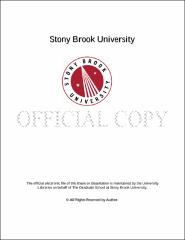| dc.identifier.uri | http://hdl.handle.net/11401/77418 | |
| dc.description.sponsorship | This work is sponsored by the Stony Brook University Graduate School in compliance with the requirements for completion of degree. | en_US |
| dc.format | Monograph | |
| dc.format.medium | Electronic Resource | en_US |
| dc.language.iso | en_US | |
| dc.publisher | The Graduate School, Stony Brook University: Stony Brook, NY. | |
| dc.type | Dissertation | |
| dcterms.abstract | This paper empirically examines the peer eects among credit rating agencies (CRA) and the credit rating shopping behavior by bond issuers in the sub-prime mortgage market. The recent sub-prime mortgage crisis has raised the controversy that CRA's rating decisions might not be independent. For example, Moody's rating decisions might be aected by S&P, and vice versa. My studies analyzes the peer eects on Moody's and S&P's rating decisions, while taking into account the selection of CRAs by bond issuers. This selection process is also called credit rating shopping. At the issuance of mortgage-backed securities, bond issuers solicit ratings from CRAs. Only the selected CRAs will make their ratings public and get paid by bond issuers. Since both the credit rating shopping and the peer effects are likely to inflate ratings, ignoring the selection stage in the estimation will lead to upward bias of peer effects. The model is estimated using the data of sub-prime mortgage-backed securities from Jan.2004 to Oct.2008. My studies shows the following findings: First, there is robust evidence of the peer effects on Moody's and S&P's rating decisions. The peer effects on S&P are stronger than on Moody's. Second, the selection process does not significantly affect CRAs' rating decisions. Third, the peer effects are small for AAA bonds, then increase significantly for medium-rating bonds, and then decline again for lower-rating bonds. Fourth, Moody's and S&P's downgrade probabilities given its peer's rating one notch lower is much higher than their upgrade probabilities given its peer's rating one notch higher at all rating levels. Fifth, choosing two agencies has complementary effect as compared to choosing only one agency. Last, the downgrading probability at investment grade is not lower than the ones around investment grade. In other words, whether a bond is at the investment grade does not affect an agency's downgrading decision. | |
| dcterms.available | 2017-09-20T16:52:39Z | |
| dcterms.contributor | Montgomery, Mark | en_US |
| dcterms.contributor | Zhou, Yiyi | en_US |
| dcterms.contributor | Brusco, Sandro | en_US |
| dcterms.contributor | Chen, Xinyun. | en_US |
| dcterms.creator | He, Bo | |
| dcterms.dateAccepted | 2017-09-20T16:52:39Z | |
| dcterms.dateSubmitted | 2017-09-20T16:52:39Z | |
| dcterms.description | Department of Economics. | en_US |
| dcterms.extent | 96 pg. | en_US |
| dcterms.format | Application/PDF | en_US |
| dcterms.format | Monograph | |
| dcterms.identifier | http://hdl.handle.net/11401/77418 | |
| dcterms.issued | 2015-12-01 | |
| dcterms.language | en_US | |
| dcterms.provenance | Made available in DSpace on 2017-09-20T16:52:39Z (GMT). No. of bitstreams: 1
He_grad.sunysb_0771E_12276.pdf: 579611 bytes, checksum: de5a23a070ed9eb520e8acf4340d07d0 (MD5)
Previous issue date: 1 | en |
| dcterms.publisher | The Graduate School, Stony Brook University: Stony Brook, NY. | |
| dcterms.subject | Economics | |
| dcterms.subject | Credit Rating, MBS, Peer Effects | |
| dcterms.title | An Analysis of Peer Effects in the Credit Rating Market | |
| dcterms.type | Dissertation | |

